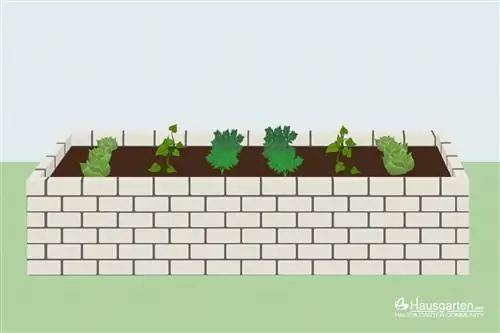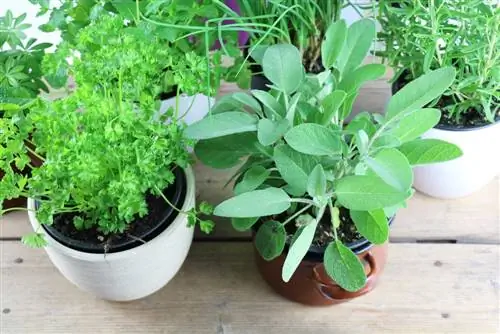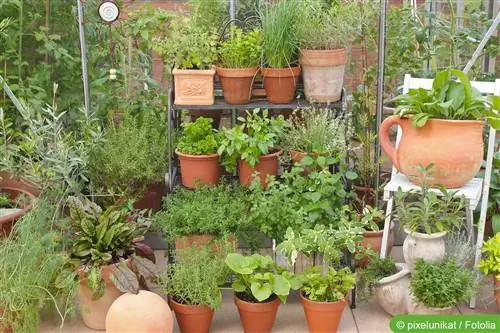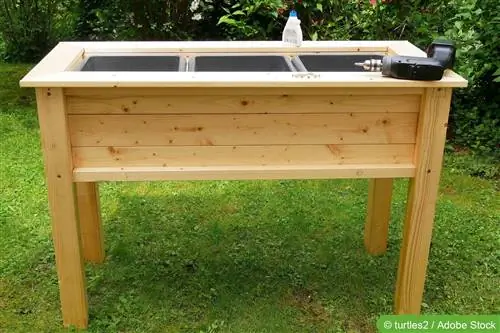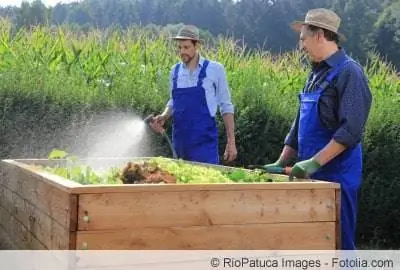- Author admin [email protected].
- Public 2023-12-17 03:39.
- Last modified 2025-01-24 12:45.
If you like to use fresh herbs in the kitchen, you can create your own raised herb bed. The different designs of raised beds make the garden, terrace or balcony a real eye-catcher. But such raised beds of course offer other advantages. Depending on how high it is built, the amateur chef does not have to bend down when picking the fresh herbs and pests have almost no chance of getting to the herbs. With the right tips and tricks, anyone can create their own raised herb bed.
The advantages
The advantages of choosing one or more raised herb beds are obvious. Not only that you can play with the different designs and thus offer the viewer an eye-catcher on the balcony, terrace and in the garden. Plants in raised beds are not as often attacked by snails and other pests because they are not in direct proximity to the ground. In addition, the soil in the oversized flower boxes stores much more heat than is the case in the garden soil. This is an advantage for the herbs, especially in spring and autumn, to grow faster and stronger. If the raised beds are protected in winter and covered with plant fleece or translucent film, the he althy herbs can continue to be harvested this time of year, as this creates a function that would otherwise be offered by a cold frame or a small winter garden.
Tip:
The higher the raised beds are, the less the ground frost will bother the herbs in winter if the soil is covered and protected accordingly.
Required materials and equipment
A raised bed is usually an oversized flower box that can be quickly built from wood. But raised beds made of stones are also very popular in local gardens. But planning always comes before construction. The location, size and height must be determined. Then the desired and required materials can be obtained and the craft tools made available. This way the work gets done quickly. The following materials and equipment are required for a conventional raised bed:
for a raised bed with a wooden border:
- Wooden boards of your choice for four sides, have them cut to the desired size at the hardware store
- If you use untreated wood, you must treat it accordingly before processing
- Wood that is exposed to the weather in the garden will swell due to rain if it is not pretreated with appropriate products
- Pubble foil
- Vole grid (depending on the location of the raised bed)
- Screws
- Cordless screwdriver
- possibly wood glue
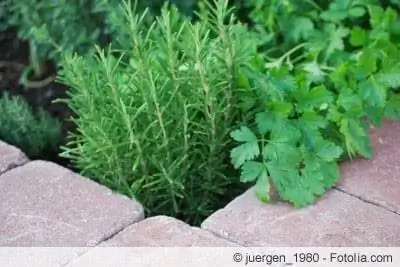
for a raised bed with a stone border:
- Natural or concrete stones of your choice
- Clinker bricks are also suitable
- Mortar
- Water hose
- Bucket for mixing
- Mason's Trowel
- Spirit level
The internal structure is the same for stone and wooden raised beds. The following natural materials are required:
- Leaves
- small branches and twigs
- chopped
- green cuttings
- Grass Sods
- Compost
- special herbal soil from the market
- or garden soil mixed with compost
Tip:
A sunny spot is ideal as a location because all herbs love sunny locations. However, it is better not to expose it to the blazing midday sun in summer. If a raised bed is created on a terrace or balcony, care should be taken to ensure that the bed receives enough sun for several hours a day; partial shade is sufficient for the rest of the day.
Completion
Raised wooden herb beds are primarily suitable for balconies and terraces; raised stone beds can also find a place in the garden. The structure in the garden goes as follows:
- screw all the wooden sides cut to size at the hardware store together at the corners
- place in the desired location
- For a raised stone bed, lay the stones on top of each other in the desired shape at the desired location
- put mortar between the individual joints
- Place vole grid on the ground
- line with bubble wrap
- give up a thick layer of leaves
- fill about 20 cm with branches and twigs
- cover with a thin layer of chaff
- add 10 cm of green waste on top
- the sod is turned over and placed on top with the earth facing up
- add another thick layer of compost and leaves over this
- finally the prepared soil can be entered
- now the raised bed is ready for the desired planting or sowing
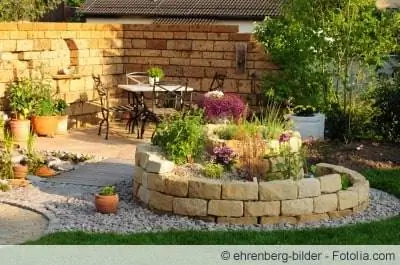
If you want to cultivate a raised herb bed on the terrace or balcony, build a wooden box of the desired size with a base. In this case, there is no need to lay out the vole grid. The interior is covered with bubble wrap before the soil is added, otherwise the wood would swell from the water.
Tip:
If you plant or sow a lot of herbs, you can also label them with small wooden signs. This means that the herbs required are immediately recognized when used in the kitchen. Such a label also looks very decorative.
Various designs
The garden can be wonderfully designed with raised herb beds, because there are many different designs and shapes, all of which develop their own charm. Either the hobby gardener decides on a clear line with just one shape or on different design options using materials and shapes for several raised beds. However, a single raised bed is suitable for small corners. This makes the herb garden an experience for everyone. Depending on how much time is to be invested in building the raised herb beds, the designs can be very sophisticated but also very simple. Every garden owner has to rely on their own taste. The different raised beds could therefore look like this:
- natural look with natural stone border, for a naturally designed garden
- Made of wood according to your taste with seating, the benches are attached directly around the raised bed
- design oversized balcony boxes for the garden out of wood
- Creating round raised beds with natural stones interrupts the garden in terms of design
- in the shape of a snail shell with natural stones, a playful eye-catcher on a meadow
- in wood look on legs, can also serve as a small winter garden with foil
- stack various wooden boxes in different sizes, ideal for terrace or balcony
- form a “snake” out of stones, also suitable as a path barrier
- stacked upwards on a house wall in the form of a ladder
Tip:
When choosing a design, the only thing that matters is your own taste. Raised stone beds in the shape of a snail shell are playful, and natural stones are also suitable for a natural garden. Square raised wooden herb beds, on the other hand, bring a clear line to the garden.
Matching herbs

The raised herb bed can be planted with all the herbs that nature has to offer. Not only do local herbs feel at home in the raised bed, tasty herbs from the Mediterranean and even tomatoes can also be cultivated here. Here are some suggestions for herbs that find their place in the raised herb bed and can even overwinter with protection:
- Chives
- parsley
- Rosemary
- Lavender
- Dill
- Chervil
- Marjoram
- Basil
- Coriander
- Sage
Tip:
If the herbs are cultivated in a raised bed near the house, they also give off a pleasant scent that can remind you of vacation and far away places.
Conclusion
A raised herb bed is suitable for every corner of the garden as well as for the terrace or balcony. Because if you build the raised herb bed yourself, you can also determine the size and shape yourself. In addition, raised beds in the garden are real eye-catchers with their many different designs. A boring, ground-level garden is interrupted by the raised beds and the herbs take center stage. Raised beds can be created quickly and easily from various stone materials or even wood. With just a few tips and tricks, it's easy to build a simple raised herb bed. Further advantages are that pests such as annoying snails or voles have almost no chance of getting to the herb plants. Since heat and nutrients are stored in the raised bed, he althy and strong growth of the various herbs is guaranteed. Finally, there are always fresh herbs in the kitchen that just have to be picked.


